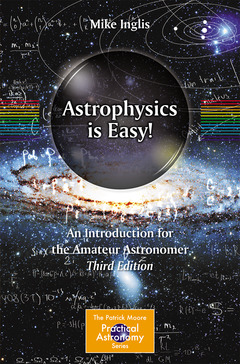Astrophysics Is Easy! (3rd Ed., 3rd ed. 2023) An Introduction for the Amateur Astronomer The Patrick Moore Practical Astronomy Series
Auteur : Inglis Michael

Astrophysics is often ?with some justification ? regarded as incomprehensible without the use of higher mathematics. Consequently, many amateur astronomers miss out on some of the most fascinating aspects of the subject. Astrophysics Is Easy! cuts through the difficult mathematics and explains the basics of astrophysics in accessible terms. Using nothing more than plain arithmetic and simple examples, the workings of the universe are outlined in a straightforward yet detailed and easy-to-grasp manner.
Following on the success of the first and second editions, this fully updated third edition covers the significant changes in astrophysics theories and research that have occurred in the last five years, including new material on: exomoons, exocomets and exoasteroids; Special and General Relativity; gravitational waves, their origins and detection; telescope optics; black hole astrophysics; and more.For each topic under discussion, an observing list is included so that observers can actually see for themselves the concepts presented ? stars of the spectral sequence, nebulae, galaxies, even black holes. The book also features in-text, nonmathematical questions and end-of-chapter problems ? all with their accompanying solutions ? to help readers discuss and digest the material.
Dr. Mike Inglis is a professional astronomer who also has a life-long passion for amateur astronomy. In addition to observing the night sky whenever he can he has worked at the University of Hertfordshire and Warwick University in the UK, at Princeton University in the USA, and used some of the world’s largest telescopes in Australia, La Palma and Hawaii. He is the author of several astronomy books for the amateur and student and has had many articles in both popular astronomy magazines and research level journals. He is currently Professor of Astrophysics at the State University of New York, USA.
Explains the workings of the universe using nothing more than arithmetic and simple examples
Includes new material on gravitational waves, Special & General Relativity, exomoons, telescopes, black holes
Contains in-text and end-of-chapter problems and solutions
Date de parution : 03-2023
Ouvrage de 454 p.
15.5x23.5 cm



